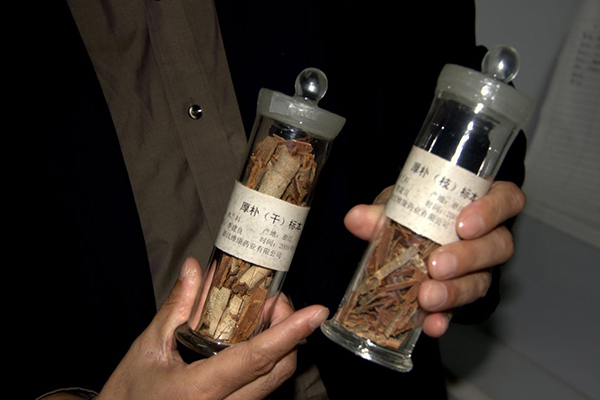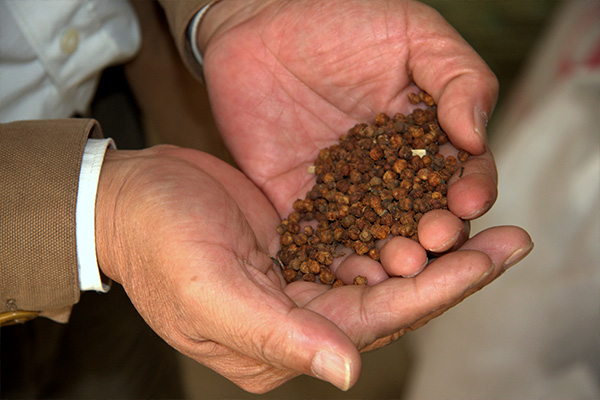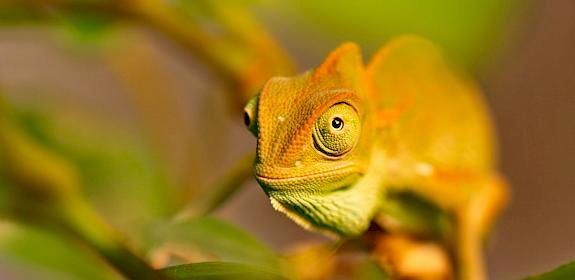COVID-19—the role of wild plants in health treatment and why sustainability of their trade matters
Cambridge, UK, 7th April 2020, World Health Day—With a strong global spotlight on wild animal markets as a likely source of the COVID-19 epidemic, it is easy to lose sight of the fact that the biggest flows of “wildlife” in trade involve plants, not animals. There are also important conservation and health reasons to be keeping a close eye on the wild plant trade sector during this global health emergency.
With the COVID-19 outbreak, the use of wild plants as herbal ingredients in the formulations for Traditional Chinese Medicine (TCM), as well as other herbal-based products around the world, is anticipated to increase dramatically. Here, we take a look at what is known about the use of herbal ingredients in TCM in addressing the COVID-19 disease so far, and what safeguards can be put in place moving on to ensure that these and other wild plant resources are available in the long-term to support healthcare.
Approximately 60,000 plant species are used globally for medicinal purposes, of which about 28,000 have well-documented use, and approximately 3,000 species are estimated to be traded internationally, with only one-third of those known to be in the commercial cultivation.[1] Information about the global threats to species survival is available for only 7% of medicinal and aromatic plants (MAPs); approximately 20% of these species are threatened with extinction in the wild based on the IUCN Red List criteria. Direct overexploitation, including for international trade, is among the key threats. For globally traded MAPs, the value of trade has nearly tripled in the past 20 years (from USD1.1 billion in 1999 to USD3 billion in 2015).
In China, plants comprise around 80% of TCM products. An estimated 30% of TCM industrial production volume is from wild plant species, accounting for 70% of the species by number. The resource base of the TCM industry is a combination of supply chains from China and from around the world. Estimating the exact figures in trade is complex. China is one of the world’s leading importers of MAPs (following Hong Kong SAR, USA, Germany and Japan, based on customs trade data reported in 2015). It is also one of the world’s leading exporters of botanical ingredients. A snapshot into the trade suggests that, in 2013, China exported over 1.3 billion kg of such material, with a reported customs value of over USD5 billion, to which wild-collected material may have contributed as much as USD1.8 billion.[2]
Use of wild plants in COVID-19 treatments

A combination of TCM and Western treatments is being used extensively in China to treat COVID-19 patients, with official COVID-19 treatment versions issued by the National Health Commission of the People's Republic of China. The efficacy of the application of herbal treatments to COVID-19 is a subject of research, for example a study that screened 125 Chinese herbal medicines with the potential directly to inhibit COVID-19,[3] and a review of historical records and human evidence of SARS and H1N1 influenza prevention.[4]
The current, 7th version of the treatment plan was issued on 3rd March 2020,[5] and is still current at the time of writing this article. Ten TCM prescribed formulations and 13 proprietary Chinese medicine formulations (including granules, capsules, injections) are included in the list of official recommended treatments.
More than 125 species of plants are ingredients in these formulations, including: Liquorice root (Glycyrrhiza spp.), a species that is protected in part of its range in China, used in 11 formulations; several CITES Appendix II-listed species: Panax spp., and Cibotium barometz. Species used in more than five formulations include: Glycyrrhiza spp., Magnolia officinalis, Scutellaria baicalensis, Ephedra spp., Armeniaca spp., Atractylodes macrocephala, Forsythia suspensa, and Pogostemon cablin.
Panax ginseng and Magnolia officinalis are grade-II listed species on China’s Protected species list, requiring their harvesting and trade to take place only with a permit from provincial authorities and under their oversight.
A sub-set of these plant species is likely to be sourced from the wild and come from both China and international markets, including liquorice Glycyrrhiza spp., American Ginseng Panax quinquefolius, and Cibotium barometz.
For example, liquorice root Glycyrrhiza spp. is used as an important TCM ingredient, “Gan Cao”. The main species found in the commercial trade of liquorice are Glycyrrhiza glabra and Glycyrrhiza uralensis, which are principally sourced from Asia and the Mediterranean region. There are concerns about the conservation status of liquorice species, with some threatened in parts of their range, along with many other wild-collected medicinal and aromatic plants. Commercial demand can put pressure on wild plant populations, placing them in danger of overexploitation. Evidence suggests that the growing and diversifying demand for wild liquorice, as well as the entry of non-traditional harvesters into the market, has resulted in traditional, often sustainable harvesting practices being replaced by more intensive and destructive practices. This can also threaten the livelihoods of traditional collectors, who are often drawn from the poorest social groups in rural areas. However, if properly managed, liquorice root can be harvested without lasting negative impacts on the population. Liquorice species regenerate strongly from the roots. In fact, liquorice was one of the first products for which sustainability standards were tested in practice. The FairWild Standard, which certifies sustainable wild harvest using a rigorous set of criteria to demonstrate sustainability of the wild resource and equitable trade in wild species, has been applied in liquorice production sites in Kazakhstan, Georgia and Spain. Liquorice root extract is specifically recommended to control COVID-19 symptoms.[6]

Use of herbal-based medicines to treat COVID-19 is similar to their use in treatments for the severe acute respiratory syndrome (SARS) disease, which have been researched since that outbreak in 2002/2003.[7] Integrated Chinese and Western medicines played an important role in the treatment of SARS in China. Among 5,327 confirmed cases, 3,104 patients received Traditional Chinese Medicine. “Current evidence shows that Chinese herbs plus Western medicine have no benefit in terms of mortality, compared with Western medicine alone. However, significant benefits in improvement of symptoms, including decreasing body temperature, cough and breathing difficulties, decreasing dosages of corticosteroids, improving absorption of pulmonary infiltration and improving quality of life, were observed. Weak evidence suggests that Chinese herbs are beneficial in shortening the number of days spent in hospital. No adverse effects of Chinese herbs were observed.”[8] Some of the most frequently used plants species in SARS treatments included Lonicera japonica, Astragalus membranaceus, Glycyrrhiza uralensis, Atractylodes macrocephala, Scutellaria baicalensis, Angelica sinensis, Panax quinquenfolius, and Schisandra chinensis.
In the COVID-19 response, the data reported in China by the National Health Commission of the People's Republic of China (during a news conference on 23rd March 2020) suggest that at the national level, 74,187 infected patients used TCM (91.5% ratio of total number of cases); in Hubei Province, 61,449 infected patients used TCM (90.6% ratio of total). From the clinical observation, the efficacy of treatment rate is above 90%.
Is the use of herbal ingredients increasing?
While there is no clear evidence yet that an increase in the volume of trade in herbal products in China has occurred and has been driven by COVID-19 prescriptions, this can be anticipated. This appears to be the case in other parts of the world. There are reported “rushes for traditional herbal medications” against COVID-19 in Thailand,[9] and ”immune-boosting” herbal capsules promoted in India,[10] traditional herbal medicines promoted by government to take up consumption against coronavirus in Bolivia,[11] and increases in traditional remedies use in Tunisia.[12] India’s Ministry of AYUSH issued a statement on “Ayurveda’s immunity boosting measures for self-care during COVID 19 crisis”,[13] which includes the recommendation to take Chyavanprash formula (containing a range of wild plant ingredients) daily. Recent news suggests that there is a rapid increase in the demand for traditional Chinese remedies for respiratory and other ailments in the US.[14] Shortages in the supplies of herbs coming out of China due to delays or port closures for container shipping from China can be expected. Despite these immediate increases, no systemic supply chain issues for the herbal industry have been documented so far.
Why does it matter and what should be done?
While the origin (wild vs cultivated or harvested in China, vs imported) of most species included in the list of recommended TCM treatments is not yet known, many species are likely to be sourced from the wild, and the use of these species to provide remedies for the COVID-19 outbreak presents a key opportunity to emphasise the importance of ensuring the long-term sustainability of the TCM sector as a supplier of herbal ingredients. While current research focuses on the likely efficacy of herbal medicines to support health care, there is a lack of attention to ensuring the sustainability of supply chains, providing the herbal ingredients, in particular those sourced from the wild.
This gap applies to sourced herbal ingredients in China and abroad. Within China, recent efforts,[15] provided insights into the industrial production of TCM products, identified key gaps around the sustainability of supply chains, and provided practical solutions to address these gaps. Solutions include the application of TCM sector corporate sustainability guidelines, as well as use of international best practices such as the FairWild Standard and certification scheme for wild-harvested species. Further emerging opportunities include proactive engagement with key TCM sectoral associations and TCM manufacturers to improve/update/develop TCM production standards, and to integrate these into sustainability sourcing practices.
Beyond China, the overall Belt and Road Initiative (BRI) has a TCM strategy,[16] which focuses on the rapid expansion of TCM centres for treatment of patients around the world. This offers important opportunities to advance sustainable use practices, and to build on opportunities to develop supply chains from the BRI countries (which range from Central Asia, to Nepal, to East African countries, and beyond). The ”greening” of this strategy is key to ensuring the long-term survival of medicinal and aromatic plant species, which could form the basis of the medicinal formulations.
The future availability of plant ingredients to support human health is dependent on prioritising the conservation and sustainable use of their source species in the long-term. Much greater action is required on the part of private sector, governments and consumers to address the long-term availability of these species.
Priority actions include:
- All stakeholders to support the assessments of use, trade and threat status of key plants, and contribute to the development of species and area management plans.
- Companies proactively to review what supply chains rely on wild plant ingredients, assess their ecological and social sustainability, build targets to demonstrate the commitment to moving all supply chains to verifiable sustainability, and implement third-party standards and certification (in particular the FairWild Standard and certification scheme).
- Countries to enable effective regulation of wild-harvesting, increase the visibility of wild plants and their contribution to livelihoods, economies, and healthcare, and promote sustainable harvest practices. This would in particular contribute to the delivery of the CBD’s Target 12 of the Global Strategy for Plant Conservation, Biodiversity and Health area of work, as well as the implementation of CITES decisions (in particular the following).
- WHO member countries join the request for formal finalisation and adoption of the WHO/WWF/IUCN/TRAFFIC Guidelines on Conservation of Medicinal Plants.
- TCM sector stakeholders to develop/integrate the requirements of sustainable sourcing and trade in existing TCM standards, including in the TCM context of the Belt and Road Initiative.
- Consumers to look out for the healthcare, food and well-being products that contain wild plant ingredients, and support best practices (such as FairWild-certified products). Join the #ifoundwild initiative
Anastasiya Timoshyna, Ling Xu, Zhang Ke
Notes:
- Jenkins, M., Timoshyna, A., & Cornthwaite, M. (2018). Wild at Home: Exploring the global harvest, trade and use of wild plant ingredients.
- Brinckmann, J. A. (2016). Sustainable Sourcing: Markets for certified Chinese medicinal and aromatic Plants. Geneva: International Trade Centre, 22.
- Zhang, D. H., Wu, K. L., Zhang, X., Deng, S. Q., & Peng, B. (2020). In silico screening of Chinese herbal medicines with the potential to directly inhibit 2019 novel coronavirus. J. Integr. Med. 18(2), 152-158. https://doi.org/10.1016/j.joim.2020.02.005
- Luo, H., Tang, Q., Shang, Y. et al. Can Chinese Medicine Be Used for Prevention of Corona Virus Disease 2019 (COVID-19)? A Review of Historical Classics, Research Evidence and Current Prevention Programs. Chin. J. Integr. Med. (2020). https://doi.org/10.1007/s11655-020-3192-6
- http://www.nhc.gov.cn/yzygj/s7653p/202003/46c9294a7dfe4cef80dc7f5912eb1989.shtml
- Redeploying plant defences. Nat. Plants 6, 177 (2020). https://doi.org/10.1038/s41477-020-0628-0
- Liu X, Zhang M, He L, Li Y. Chinese herbs combined with Western medicine for severe acute respiratory syndrome (SARS). Cochrane Database of Systematic Reviews 2012, Issue 10. Art. No.: CD004882. https://cochranelibrary.com/cdsr/doi/10.1002/14651858.CD004882.pub3/full
- Liu X, Zhang M, He L, Li Y. Chinese herbs combined with Western medicine for severe acute respiratory syndrome (SARS). Cochrane Database of Systematic Reviews 2012, Issue 10. Art. No.: CD004882. https://cochranelibrary.com/cdsr/doi/10.1002/14651858.CD004882.pub3/full
- https://www.bangkokpost.com/thailand/general/1880490/covid-19-fear-fuels-rush-for-traditional-herbal-medication
- https://economictimes.indiatimes.com/magazines/panache/covid-19-boost-your-immunity-with-dalmia-groups-herbal-capsule/articleshow/74684873.cms
- https://www.nytimes.com/reuters/2020/03/21/world/americas/21reuters-health-coronavirus-bolivia-tradition.html
- https://www.middleeasteye.net/video/tunisians-turn-traditional-herbal-medicines-amid-coronavirus-fears
- http://ayush.gov.in/sites/default/files/Immunity%20Boosting%20-%20%20AYUSH%20Advisory.pdf
- https://www.reuters.com/article/us-health-coronavirus-usa-herbs/u-s-coronavirus-threat-fuels-demand-for-traditional-herbal-remedies-idUSKBN20W2GR
- Engaging China’s private sector in sustainable management of medicinal plants project website: https://www.traffic.org/what-we-do/projects-and-approaches/promoting-sustainable-trade/fairwild/egp-maps/
- Hinsley, A., Milner-Gulland, E.J., Cooney, R. et al. Building sustainability into the Belt and Road Initiative’s Traditional Chinese Medicine trade. Nat Sustain 3, 96–100 (2020). https://doi.org/10.1038/s41893-019-0460-6





